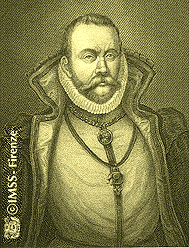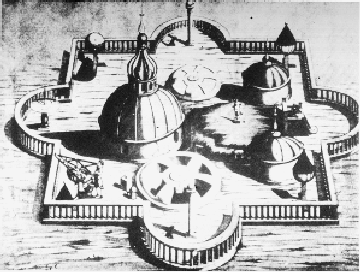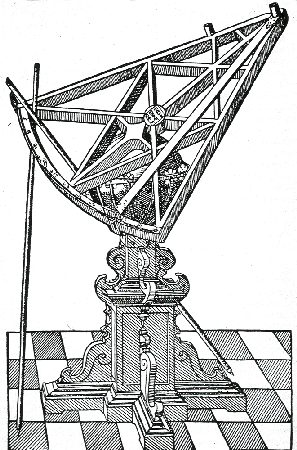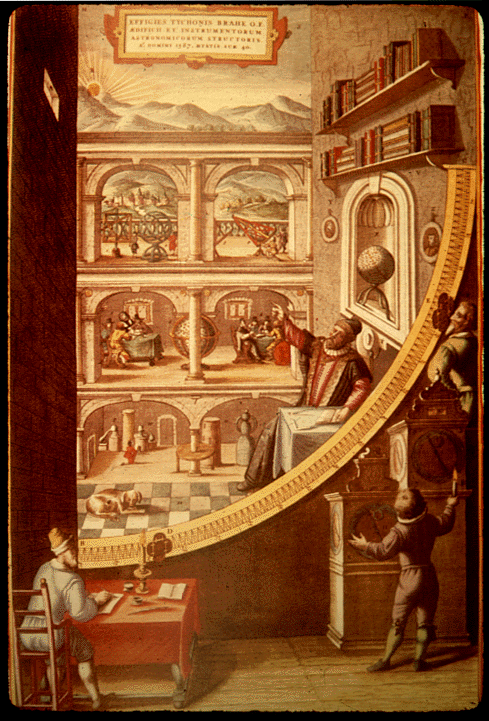
Nicolaus Copernicus, 1473-1543 ,b. Torun, Poland. After a wide and extensive education, become canon of the cathedral in Frauenberg (now Frombork), where he devotedly served for the remainder of his life. His hobbies included astronomy, where he grew frustrated by Ptolemy's model of planetary motion (he thought it was too complicated). He may or may not have known of Aristarchus's sun-centered model, but in any event, he developed his own, in great detail. The book that explained the model, De Revolutionibus Orbium Coelestium [The Revolution of the Heavenly Orbs; or De Revolutionibus for short] was published the year Copernicus died. Copernicus probably recognised that the sun-centered view would be controversial because of its blatant contradiction of Aristotle and even a few bible passages that referred to the sun as "rising" or "stopping in the sky" for Joshua. The model also seemed to violate "common sense" because the earth was perpetually moving at large velocity around the sun and also spinning on its axis once a day; Aristotle tells us that the natural state of motion is rest, not motion.
Copernicus's model placed the sun at the center of the "universe", with the planets placed in the order we learned in elementary school: Mercury, Venus, Earth, Mars, Jupiter, and Saturn, with the moon orbiting the Earth. Although the heliocentric view explained in a natural way the retrograde motion of the planets, Copernicus still followed Ptolemy's and Aristotle's aesthetic restriction that all heavenly motion must be "uniform and perfectly circular." This meant that he could not get the model to work without epicycles, albeit ones that were much smaller than those of Ptolemy.


Tycho Brahe, 1546-1601 , b. southern Sweden, then part of Denmark. Tycho became the greatest observational astronomer since Hipparchos. He was of noble birth, and was educated in Denmark, Germany, and Switzerland. During this time he lost his nose in a sword fight with a fellow student over who was the better mathematician. Tycho was keenly interested in astronomy, and observed a conjunction (pairing) of Jupiter and Saturn when he was 17. He was impressed that the conjunction was predicted by Ptolemy's model, but disgusted that the prediction was several days off. At some point he realized that the observational data - the positions of the planets recorded by Hipparchos - could be greatly improved, and he turned himself to this task, aided by the fact that he was independently wealthy. He built a small observatory upon his return to Denmark.
Shortly after, a "new star" appeared; today, we call it "Tycho's supernova". It was brighter than Venus for a time and became too faint to see after a year and a half. Tycho made positional measurements of this new star and found that it did not move at all in the sky, implying that it really was a star. Not only did this contradict Aristotle's "perfect and unchanging" rule for the stars, Tycho's timely observations made him so famous that the king of Denmark gave him an entire island, complete with castle, servants, and lands to raise food and extra money. Tycho built several "quadrants," position-measuring devices that were as accurate as the human eye allowed: about one minute of arc, or 1/60th of a degree, 50 to 100 better than the ancient catalogs. Over the next 20 years, Tycho measured the positions of the planets and a list of 777 stars to this astounding accuracy.
The death of the Danish king combined with Tycho's arrogance caused him to move to Prague in 1599, where he met a young mathematician interested in the problem of planetary motion named Johannes Kepler. Tycho died two years later, ironically enough by complications due to being polite: at a feast it is impolite to take a bathroom break until the host does. As Tycho ate and drank with a local baron one evening, he become more and more dismayed when the baron did not get up. Tycho went home in some pain and died 11 days later of the subsequent urinary tract infection.


Tycho's observatory at Uraniborg

Tycho's observatory at Uraniborg

A sextant used by Tycho

A rendering of one of the large quadrants used for position
measurements at Uraniborg.
Johannes Kepler, 1571-1630, b. near Wurttemburg, southwest Germany. I like to think of Kepler as the Mozart of astronomy, in terms of genius and lifestyle: both were always scraping for money, both were driven by their inner quests for perfection. After divinity school Kepler accepted a rather lowly job teaching mathematics at Graz, southeast Austria. Kepler did not know much mathematics and spent a rough first year trying to keep ahead of his students. At the end of this year, he became obsessed with what turns out to be a coincidence: there are 5 naked-eye planets and 5 "regular solids:" the tetrahedron (4 sides shaped like equilateral triangles), the cube (6 square sides), the octahedron (8 triangle sides), the dodecahedron (12 pentagons), and the icosahedron (20 triangles). Kepler then spent hours trying to nest solids within solids to explain the spacing of the planets (in a Copernican model, which he preferred because of its simplicity).
Kepler drives me nuts because he was such a mystic, believing in, apparently, several contradictory things at once. For instance, even after he figured out that the planets orbited on elliptical paths, he still spent years trying to discover a connection to the 5 regular solids.
Kepler's next step was why we revere him: he subjected his theory of nested solids to the observational test, demanding that the theory fit the observations to within the observational error. Well, the theory didn't fit, especially for Jupiter and Saturn. Well, reasoned Kepler, maybe the observations are wrong. So Kepler wrote to Tycho, asking, politely, for Tycho's data on planet positions.
After two years of correspondence (Tycho wasn't about to give out more than a tiny fraction of his data) Tycho was forced out of Denmark to Prague and he invited Kepler to join him, which he did. After a couple of frustrating years for Kepler, in which Tycho would not release enough data for Kepler to get much use out of, Tycho died, and Kepler came into his scientific inheritance, with full access to Tycho's notebooks full of planetary positions.
Kepler was also lucky enough to have a supernova go off just in time to do his career good: he wrote a book about it and gained international fame. "Kepler's supernova" went off in 1604.
Between 1601 and 1609, Kepler doggedly pursued his determination to find a model for planetary motions that matched the observations. He finally disgarded "uniform circular motion" and began investigating alternatives. What shape the orbit? Does the planetary velocity vary? In what way? Well, he found the answers. Planets orbit on elliptical paths and the speed varies in such a way as to ensure that a sun-planet line sweeps out equal areas in equal times. These two principles are now taught to astronomy students as Kepler's first and second laws. The book describing them, Nova Astronomia (New Astronomy) was published in 1609. Kepler's third law that relates planet distances to their orbital periods had to wait for Kepler to triangulate positions for the planets, and wasn't published until 1619. For us, these three laws are Kepler's achievements, but Kepler knew that his contemporaries would not be satisfied until he, like Ptolemy and Copernicus, made tables of planetary positions good for both past and future. He was finally able to do this, paying publishing charges from his own pocket. The Rudolphine Tables were published in 1627. Amid the unhappiness of his later life, this must have been some comfort to him.
For science, they provided a siren song that we still follow: A theory must match the observations within observational error. This is the sword by which incorrect theories are discarded.

While a professor of mathematics at Padua, Galileo heard descriptions of a recent Flemish invention, the telescope, built with two convex lenses. Galileo worked out the geometry of this arrangement and built a telescope that magnified objects by a factor of ten. After getting a pay raise for this, he designed a more powerful version and pointed it at the sky, thereby changing astronomy forever.
These findings, most of them published in 1610 in a book called the Starry Messenger, demolished the Ptolemaic/Aristotlean cosmology, most especially the observations of the phases of Venus, which could never be fully illuminated in Aristotle's world-view. There was a hybrid model, created by Tycho Brahe, in which the earth remained at the center, the sun and moon revolved around earth, and all the planets revolved around the sun. This model was never widely adopted because it was so ungainly, but its existence caused debate for years, and was clung to by all who "knew" that the earth was at the center of the universe.
Around 1611, Galileo ran into some trouble with the Church, which had embraced the Aristotlean cosmology. He was made to promise not to publish anything that implied that the Copernican view was real. He was careful to keep any remarks on the correctness of the Copernican sun-centered view repressed or expressed hypothetically until 1632, when, emboldened by good relations with the pope and some cardinals, he published his "Dialog on the Great World Systems" which was blatantly pro-Copernican. In 1633, at age 70, he was convicted of heresy and placed under house arrest for the rest of his life (9 more years, as it turned out).
During his last years, Galileo had a couple very good assistants who helped him write a masterful book about the motion of bodies (basically, what we teach in first-semester physics). This book provided the foundation for the great leaps in understanding contributed by Isaac Newton.
Regarding the state of the sun-centered model for the universe, by the time of Galileo's death most scientists ("philosophers") were convinced it was true. With Ptolemy's model proven incorrect (and Tycho's hybrid model not very appealing) plus the breathtaking simplicity and accuracy of Kepler's ellipses, anybody capable of understanding all the facts usually sided with Kepler and Galileo. Opposition was not wiped out, however, until Newton worked out his elegant dual theories of motion and universal gravitation.


Galileo

Telescopes assembled and used by Galileo.
Isaac Newton, 1642-1727, b. Woolsthorpe, Lincolnshire, England. Deemed by many to be the "greatest scientist of all time." Working in near-isolation during his twenties, he wondered if gravity caused not only an apple to fall to the ground, but caused the moon to orbit around the earth as well. Like a weight whirled around on the end of a string, gravity (not string tension) might be the force that keeps the moon from flying away from the earth. Extrapolating from how fast objects fall on earth, he calculated an orbit time for the moon - and it came out 29 days. Newton's genius continued as he worked out 3 mathematical laws of motion to go with his law of gravity. And he went even further, inventing calculus (he called the method "fluxions") so that he could describe motions in purely algebraic form.
By the end of this, Newton could start with the gravity law and prove all three of Kepler's laws of planetary motion! Further, the same formulae applied equally well to the moons of Jupiter or Earth's own moon.
Newton was very pleased with his work, but made no move to publish it until Edmund Halley, an astronomer (the first to recognise that the comet that bears his name visits repeatedly every 76 years), persuaded Newton to publish. Newton commenced on the book and in a few years the Principia was published, to the instant acclaim of every mathematician and philosopher who read it. Newton was immediately famous, and justifiably so.
"Newtonian mechanics," as it is now called, is the foundation of the fields of physics and engineering. The industrial revolution may not have been possible if it had not been for the awesome predictive power of Newton's laws. He also invented the reflecting telescope (built with mirrors, not lenses) that is now the mainstay of astronomy.

| Copernicus |
|
| Tycho Brahe |
|
| Johannes Kepler |
|
| Galileo Galilei |
|
| Isaac Newton |
|